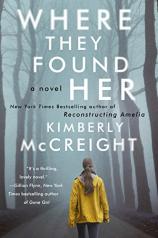Where They Found Her
Review
Where They Found Her
One can’t build little white picket fences to keep the nightmares out. It’s a sentiment that author Kimberly McCreight has used on the title page to begin her second novel, WHERE THEY FOUND HER. The quote comes from poet Anne Sexton, whose own mental illness and life as a ’50s housewife, along with frequent mental breakdowns as late as age 28, fueled her into a Pulitzer Prize-winning poet. The connection here to McCreight’s sophomore effort is of another young mother who suffers from depression: Molly Sanderson, a freelance reporter who is new to Ridgedale, New Jersey. She is given the assignment of reporting on a dead body near the Essex Bridge. When she finds out that the victim is an infant --- one year earlier, Molly lost her own unborn child --- the opportunity becomes both a way of furthering her career and an attempt to confront her past.
"WHERE THEY FOUND HER is an entertaining novel that’s a sharp and easy read. It does have much in common with RECONSTRUCTING AMELIA, which also dealt strongly with teenagers and tragedy within their lives."
Three competing storylines occur in WHERE THEY FOUND HER, broken up further by comments from Ridgedale residents regarding Molly’s news articles. We intermittently are privy to Molly’s therapy sessions, where she opens up about how her unborn child died and her subsequent feelings of guilt. In Sexton’s real-life therapy sessions, postpartum depression and her sexual awakening were discussed, while she slipped in and out of manic states, which fueled the deep confessional voice that brought her to the top of the poetry world. By contrast, we don’t question Molly’s mental stability quite enough or feel the weight of her past. It’s laid out with a fair amount of certainty that, despite her suffering, she’s still a rational, headstrong, logical protagonist. We never fall into the deep end with her and see her scars. A small hint of deeper psychosis would have gone a long way for the development of her character.
In addition to Molly, we follow a young girl named Sandy Mendelson. She wakes up one day to find an eviction notice, her mother Jenna gone, and hidden money disappeared. Their connection to the rest of the story intertwines nicely into the narrative. In fact, one of the best parts of the book is when we periodically get taken back to 1994 and are given journal entries from Jenna herself. Sandy continues the search for her mother, bringing up clues to her whereabouts, all while Molly is pressing the police chief, Steve Carlson, about information concerning the case. Steve’s wife, Barbara, along with daughter Hannah and son Cole, also share chapters in which we are given more and more hints as to the identities of the child found at the bridge and the parents. Cole is suddenly suffering from mental issues --- he has seen something he’s not divulging, and it becomes obvious to Barbara that he needs help. When a drawing of a severed arm appears, she phones the therapist, and Cole becomes one more piece of the puzzle.
McCreight tells a neatly woven story, but it feels routine at times and doesn’t build on its strong premise until the novel’s final acts. Interestingly enough, portions are dedicated to comments on articles much like one would find on any news website, while others are part of a chat room called Frat Chat. They add little, with the exception of one user who routinely posts the same message: FIND HIM BEFORE HE FINDS YOU. One gets the feeling that a firework has gone off, but we’re let down without the promise of another or even a few deeper twists to the narrative. When we want to be pushed to the limits, we’re taken back. Or when we want the story to go over the edge, we’re safely given harbor.
Though not a true page-turner, WHERE THEY FOUND HER is an entertaining novel that’s a sharp and easy read. It does have much in common with RECONSTRUCTING AMELIA, which also dealt strongly with teenagers and tragedy within their lives. But while the earlier book tended to sail, in McCreight’s latest, the monsters that do appear tread rather lightly and ease in politely when they should be turning those little white picket fences to dust.
Reviewed by Stephen Febick on April 17, 2015
Where They Found Her
- Publication Date: April 19, 2016
- Genres: Fiction, Psychological Suspense, Psychological Thriller, Suspense, Thriller
- Paperback: 352 pages
- Publisher: Harper Perennial
- ISBN-10: 0062225472
- ISBN-13: 9780062225474





